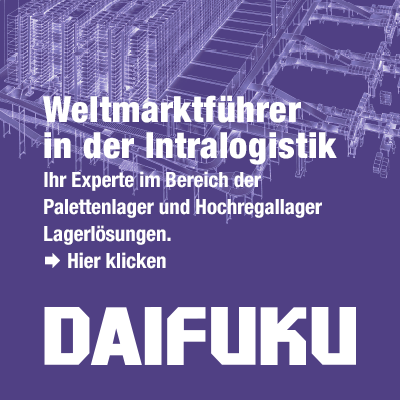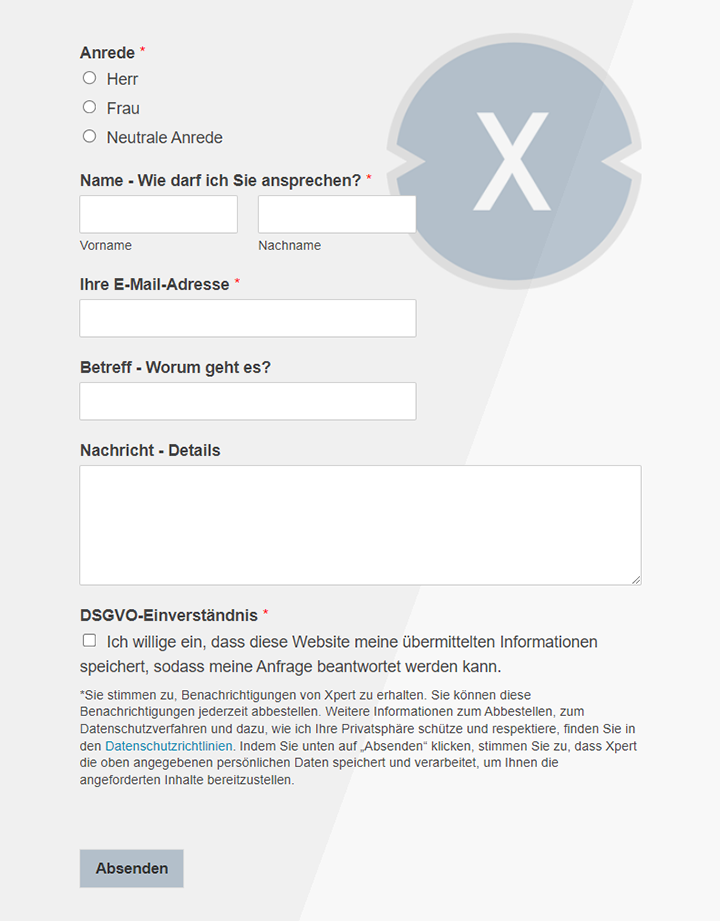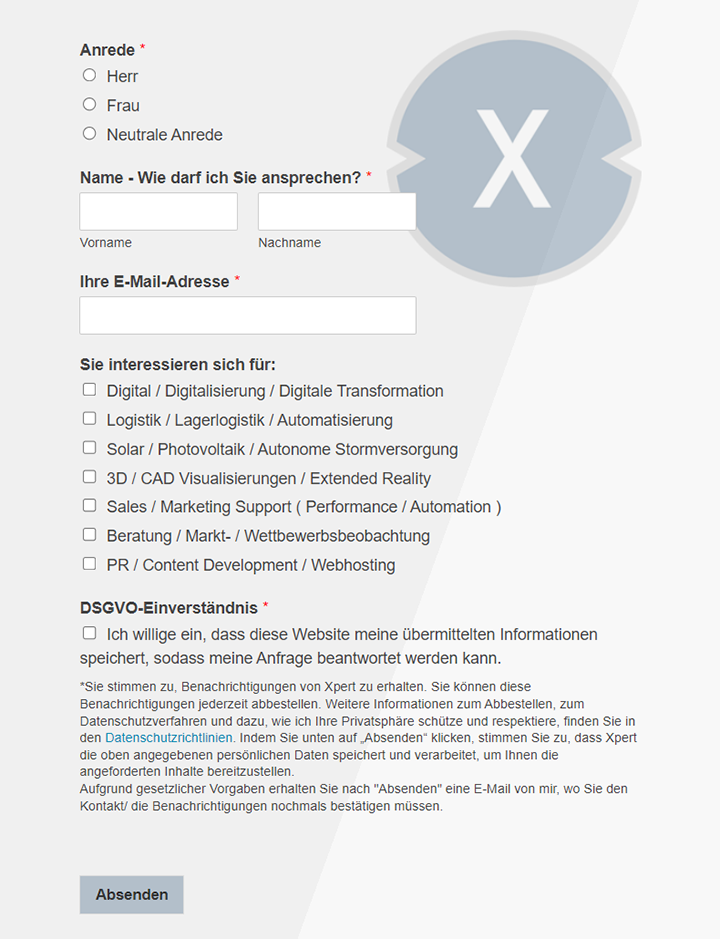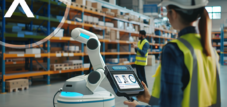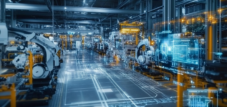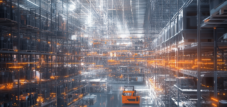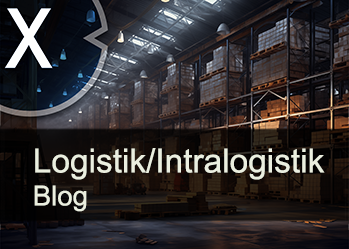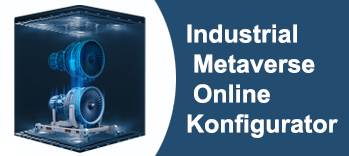Intralogistics chaos? Robot transformation in intralogistics: AI takes the tax-3 ways to digital rescue
Xpert pre-release
Language selection 📢
Published on: March 5, 2025 / update from: March 5, 2025 - Author: Konrad Wolfenstein

Intralogistics chaos? Robot transformation in intralogistics: AI takes over the tax-3 ways to digital rescue-Image: Xpert.digital
Key to competitiveness: intralogistics in digital change
Intralogistics in the digital age: increase in efficiency and reduction in costs through smart solutions
In today's business world, which is characterized by speed, flexibility and efficiency, intralogistics play a decisive but often underestimated role. Although it forms the backbone of every producing or distribution -oriented company, digitization in this area still has a shadowy existence in many organizations. In the intelligent networking and automation of the internal material rivers, there is enormous potential to optimize processes, reduce costs and to strengthen competitiveness sustainably.
However, reality often looks different. Internal transports, picking processes, warehouses and material movements are often carried out with outdated systems, manual processes and high personnel expenses. This not only leads to unnecessary time delays and increased costs, but also carries the risk of errors, inefficiencies and a lack of transparency across the entire value chain. At a time when companies are under enormous pressure, optimizing their processes and adapting to quickly changing market conditions, it is therefore essential to wake up intralogistics from their sleeping beauty and to catapult them into the digital age.
Automation and flexibility as a key to success
In the area of automation and robotics, central trends are currently identified in intralogistics. One focus is on the simple integration of new developments in existing infrastructures and their scalability in order to be able to react flexibly to changed requirements. On this basis, digitized and automated processes can make a significant contribution to increasing productivity and flexibility along the supply chains. In addition, rising energy prices and stricter legal requirements lead to an increasing demand for efficient and sustainable solutions.
Many companies present the current economic challenges and dynamic market requirements before complex tasks. Regulatory requirements, such as the cyber resilience act, as well as ambitious climate goals make measures to improve IT security and sustainability. However, the development and implementation of new automation solutions-in particular their integration into existing processes and IT systems-is associated with high costs and considerable use of resources. In addition, proprietary interfaces make the seamless cooperation of solutions of different manufacturers difficult.
A possible answer to these challenges offers the use of digital ecosystems that create new forms of networking and thus expand the scope for action. Scalable automation solutions enable to start with smaller projects and gradually expand systems if necessary, which offers both short -term advantages and long -term investment security. Open automation standards and preconfigured, mechatronic solutions can also accelerate the planning and commissioning of new and existing systems. The use of design tools, simulation models and the remanufacturing of automation components is proposed to use more efficient resource use. Specific technologies, such as service drive systems with energy management functions, can contribute to the optimization of energy consumption. Digital ecosystems also promote networking and cooperation both within and outside of companies.
Suitable for:
- Europe's way to technological sovereignty through AI-based automation: An analysis of the Kiro 2024 recommendations
Integration, AI and sustainability as competitive advantages
Experts in logistics and supply chain management emphasize the central importance of the comprehensive integration of machines and processes into IT systems. This integration forms the basis for automation, optimized control and AI-based decisions. In the course of a stronger focus on increasing efficiency, the use of artificial intelligence and machine learning is becoming increasingly important in order to optimize processes and to be able to react flexibly to changes. The networking of systems becomes a significant competitive advantage. With regard to legal requirements and growing environmental awareness, resource conservation in intralogistics is also becoming increasingly important. Sustainability will be considered a basic expectation in the future.
At the same time, the increasing individualization of the requirements for intralogistics comes to the fore - from specific shipping regulations to the optimization of manufacturing processes. Flexibility in IT systems that can be seamlessly integrated into existing processes becomes essential. The shortage of skilled workers represents another challenge, which is why systems must not only be powerful but also intuitive.
In order to successfully cope with the challenges of intralogistics in the coming years, companies are recommended to develop and implement a clear digitization strategy at an early stage. The focus should not only be on digitizing existing processes, but also thinking again-with special attention to flexibility and user-friendliness. A holistic approach that takes into account both technological and human aspects is considered crucial. New technologies should be targeted and only used where they offer real added value.
Digital processes, automation and sustainability as a driver
Experts from the field of strategy and solutions of leading providers of industrial trucks and intralogistics solutions emphasize several central trends. The first trend consists in the transformation towards digital business processes, which, for example, increase efficiency in warehouse management, the use of industrial trucks and maintenance. The second important trend is the automation of material flow processes. Here, scalable solutions make it attractive, especially for medium -sized companies. Another important aspect is the development towards more sustainable manufacturing processes and products that meet both legal requirements and increased customer requirements. Alternative energy options for industrial trucks play a key role. In addition, the stronger integration of applications with artificial intelligence is becoming increasingly important.
It is emphasized that companies are currently confronted with challenges such as increasing cost pressure, shortage of skilled workers, demographic change, demands on more sustainability and the need for resilience in supply chains and a high level of operational security. To meet these challenges, be it essential to invest in new technologies.
A continuous review of the material flow processes is recommended as a solution to identify potential for improvement, for example through automation repetititive logistics processes. An extensive solution portfolio includes driverless transport systems (FTS) and mobile robots, scalable software solutions for planning and commissioning as well as advisory and service services. The stronger integration of AI applications is also considered a decisive future trend.
Xpert partner in warehouse planning and construction
Expert analysis: Future strategies for intralogistics
In-depth analysis of intralogistics trends 2025 and beyond
The experts' assessments draw a clear picture of the most important trends that will shape intralogistics in the coming years. Some comprehensive topics can be identified that are of central importance for companies:
1. Automation and robotics: the way to increase efficiency and flexibility
The automation and use of robotics in intralogistics are no longer a future music, but already a reality in many companies. This trend will increase in the coming years, driven by the desire for increasing efficiency, cost reduction and flexibility. Automation solutions range from simple conveyor belts and automatic storage systems to complex driverless transport systems (FTS) and mobile robots.
Suitable for:
Automated Guided Vehicles (AGVs)
FTS are self -driving vehicles that can transport material within the warehouse or production without a human driver. They navigate using sensors and software and can take on complex routes and tasks. FTS offer the advantage that you can work around the clock, do not need breaks and have a high precision and reliability. They are particularly suitable for repetitive transport tasks and can significantly accelerate and optimize the material flow in companies.
Mobile robots
Mobile robots go one step further than FTS. They can be used more flexibly and can also take on complex tasks such as picking, sorting and packaging. Modern mobile robots are equipped with advanced sensors, cameras and AI algorithms that enable them to move in dynamic environments, to recognize obstacles and to work with people. They offer high flexibility and scalability and can quickly adapt to changed requirements.
Automated storage systems
Automated storage systems, such as high-bay warehouse or shuttle systems, enable efficient storage and picking of goods. They are characterized by high storage density, fast access times and precise existing management. Automated storage systems can reduce the space requirement in the warehouse, shorten picking times and minimize the error rate.
Suitable for:
- From buffer storage for fresh logistics and refrigerated logistics warehouses to automated AI high-bay warehouses and pallet warehouses
Robotics in picking
The picking, i.e. the compilation of orders, is a particularly personnel -intensive and error -prone process in intralogistics. Robotics offer great potential here to increase efficiency and reduce the error rate. Commissioning robots can take on various tasks, such as gripping and placing articles, packaging and labeling. They work precisely and quickly and can significantly improve the picking performance.
The advantages of automation and robotics in intralogistics are diverse:
Increased efficiency and productivity
Automated systems work faster, more precisely and around the clock, which leads to a significant increase in efficiency and productivity.
Reduced costs
Automation reduces personnel costs, errors minimized and resources are used more efficiently, which leads to significant cost savings.
Improved flexibility and scalability
Automated systems can be flexibly adapted to changed requirements and can be quickly expanded or converted if necessary.
Increased security
Automated systems can take on dangerous or repetitive tasks, which increases security at work and reduces the risk of work accidents.
Improved quality and accuracy
Automated systems work more precisely and reliably than manual processes, which leads to higher quality and accuracy in intralogistics.
2. IT integration and artificial intelligence (AI): Data as a fuel for optimization and decision-making
The comprehensive integration of machines, systems and processes in IT systems is another central trend in intralogistics. This integration creates the basis for transparent data recording and analysis, which in turn forms the basis for optimization potential and AI -based decisions. Modern intralogistics systems are closely networked with overarching systems such as Enterprise Resource Planning (ERP), Warehouse Management Systems (WMS) and Manufacturing Execution Systems (MES) to ensure consistent flow of information.
Warehouse management systems (WMS)
WMS are software solutions that optimize warehouse management and all associated processes. They enable efficient control of goods receipt, warehousing, picking, packaging and shipping. WMS offer functions such as storage management, inventory management, order management, tour planning and reporting. They ensure transparency in the warehouse, optimize the warehouse processes and reduce errors.
Artificial intelligence (AI) and machine learning (ML)
AI and ML play an ever greater role in intralogistics. They enable large amounts of data to analyze, recognize patterns, create forecasts and optimize processes. For example, AI applications in intralogistics include:
Need forecasts
AI algorithms can analyze historical data, seasonal fluctuations and external factors in order to create more precise demand forecasts. This enables optimized warehousing and production planning.
Route optimization
AI can calculate the optimal routes for FTS and mobile robots to shorten transport routes and minimize throughput times.
Dynamic storage position optimization:
AI can dynamically optimize storage spaces to shorten the picking trails and optimally use the storage capacity.
Quality control
AI-based image recognition systems can automatically check products for errors or damage and improve quality assurance.
Predictive maintenance
AI can analyze sensor data of machines and systems in order to identify maintenance requirements at an early stage and to avoid downtimes.
The advantages of IT integration and AI in intralogistics are enormous:
Improved transparency and database
The IT integration creates continuous data recording and analysis, which enables comprehensive transparency across all intralogistics processes.
Optimized processes and decisions
AI-based analyzes and forecasts make it possible to continuously optimize their processes and make well-founded decisions.
Increased responsiveness and flexibility:
Due to the real-time data and AI-based analyzes, companies can react faster to changes and make their intralogistics more flexible.
Proactive maintenance and avoidance avoidance
Predictive maintenance with the help of AI enables maintenance needs to be recognized early and minimizing downtime, which increases the system availability.
New business models and services
The digitization of intralogistics opens up new opportunities for data-based business models and services, such as logistics-as-a-service or predictive maintenance services.
3. Sustainability and resource conservation: Responsibility for the environment and future
Sustainability and resource conservation are not only ethical obligations, but also increasingly important competitive factors for companies. Legal requirements, increasing environmental awareness of customers and the pressure of investors force companies to make their processes more sustainable - also in intralogistics. This affects various aspects:
Energy efficiency
The intralogistics is an energy -intensive area, in particular through the use of industrial trucks, conveyor belts and automated storage systems. Companies are increasingly relying on energy -efficient technologies, such as:
Electric pall conveyors
Electrical flag trucks are significantly more energy-efficient and less emission than diesel or gas vehicles. Modern electric vehicles also offer a comparable performance and range such as combustion vehicles.
Energy recovery
Energy can be recovered and reused in the case of braking processes or lowering movements of loads. This reduces energy consumption and operating costs.
LED lighting
The use of LED lighting in the warehouse and in production can significantly reduce energy consumption for lighting.
Energy management systems
Energy management systems monitor and optimize energy consumption in intralogistics and help to identify savings potential.
Material efficiency
A gentle handling of resources and reducing material consumption and waste are important goals of sustainable intralogistics. This can be achieved by:
Optimized packaging
The use of recyclable or reusable packaging materials and the reduction of the packaging volume can reduce material consumption and waste.
Circular economy
The reuse of materials and components, the recycling of waste and remanding of products contribute to protecting resources and reducing environmental pollution.
Digital documentation
The conversion of paper -based documentation to digital processes reduces paper consumption and protects resources.
Emission reduction
Reducing emissions, especially CO2, is a central goal of sustainability. In intralogistics, this can be achieved by:
Use of low -emission or free drives
The switch to electrical or hydrogen drives for industrial trucks and other means of transport reduces emissions.
Optimized transport routes
Route optimization using AI can shorten transport routes and reduce fuel consumption and emissions.
Consolidation of transports
The summary of programs and avoiding empty rides reduce the transport expenditure and emissions.
Compensation of emissions
Companies can compensate for inevitable emissions through investments in climate protection projects.
The advantages of sustainability in intralogistics are varied:
Reduced costs
Energy efficiency and resource conservation lead to lower operating costs and can increase competitiveness.
Improved image and customer loyalty
Sustainable action is increasingly expected by customers and business partners and can improve the image and customer loyalty.
Compliance with legal requirements
Stricter environmental requirements and laws require sustainable processes and products. Companies that rely on sustainability at an early stage have an advantage here.
Contribution to environmental protection
Sustainable intralogistics makes an important contribution to environmental protection and the protection of natural resources.
Long -term competitiveness
Sustainability will be a decisive competitive factor in the future. Companies that adapt to this trend early on secure long -term competitive advantages.
Challenges and solutions for the intralogistics of the future
In addition to the trends mentioned, companies in intralogistics also face a number of challenges that need to be mastered. This includes in particular:
Economic pressure and cost reduction
The global competition and the current economic situation force companies to reduce their costs and work more efficiently. Intralogistics play a crucial role here because it makes a significant share in the total costs.
Shortage of skilled workers and demographic change
The shortage of skilled workers is an increasing problem in many industries, also in logistics. At the same time, demographic change leads to an aging workforce and a decline in the employed population. Companies therefore have to find ways to do more with fewer staff and increase the attractiveness of jobs in intralogistics.
Suitable for:
- Global shortage of skilled workers: skilled workers from abroad? Why the market doesn't cooperate and the arguments are ethically questionable
Complexity and individualization
The increasing variety of products, shorter product life cycles and individualized customer requests lead to increasing complexity in intralogistics. Companies must be able to react flexibly to these requirements and to adapt their processes accordingly.
Sustainability requirements and regulatory
Stricter environmental regulations and laws as well as the growing pressure of customers and investors require sustainable intralogistics processes. Companies have to invest in sustainable technologies and processes and make their sustainability achievements transparent.
Security and resilience
The intralogistics must not only be efficient and flexible, but also safe and resilient. Disorders in the supply chain, cyber attacks or natural disasters can lead to considerable damage. Companies must make their intralogistics systems more resistant and take measures to minimize risk.
In order to successfully counter these challenges, companies have to pursue various solutions:
Holistic digitization strategy
A clear digitization strategy is the basis for a successful transformation of intralogistics. This strategy should define the most important goals, measures and schedules and include all areas of intralogistics.
End-to-end process optimization
Digitization should not only optimize individual processes, but also look at the entire value chain from start to finish. End-to-end process optimization enables inefficiencies and media breaks to be removed and ensuring a continuous flow of information.
Focus on flexibility and scalability
Intralogistics systems must be flexible and scalable in order to be able to quickly adapt to changed requirements. Modular systems, cloud-based solutions and standardized interfaces enable high flexibility and scalability.
User -friendliness and employee participation
New technologies and systems not only have to be efficient, but also user -friendly and intuitive. Employees must be involved in the digitization process and receive the necessary training and support.
Targeted technology selection and introduction
Companies should evaluate new technologies and only use where they offer real added value. Careful planning, pilot projects and a gradual introduction are important for a successful technological idea.
Collaborations and partnerships
Instalogistics is a complex area that often requires special expertise and technologies. Cooperation with technology providers, logistics service providers and research institutions can help companies optimize their intralogistics and promote innovations.
Continuous improvement and innovation
The digitization of intralogistics is a continuous process. Companies must regularly check their processes and systems, identify improvement potential and drive innovations in order to remain competitive.
Instalogistics as the key to competitiveness in the digital age
Instalogistics is a crucial success factor for companies in today's economy. Digitization and automation of internal material rivers offer enormous potential to increase efficiency, reduce costs, increase flexibility and achieve sustainability goals. Companies that recognize the signs of time and consistently digitize and modernize their intralogistics will secure a decisive competitive advantage and be well equipped for the challenges of the future. The expert opinions confirm that the intralogistics of the future of automation, IT integration, artificial intelligence and sustainability will be shaped. Companies that take up these trends and use the right strategies and technologies will transform their intralogistics into a real competitive advantage and sustainably strengthen their position in the market. It is time to free intralogistics from its shadowy existence and to focus on corporate management as a strategic success factor.
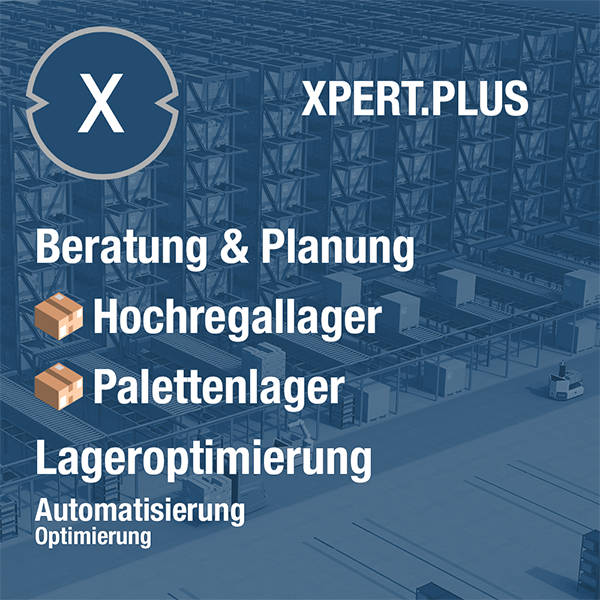
Xpert.Plus warehouse optimization - high-bay warehouses such as pallet warehouses consulting and planning
We are there for you - advice - planning - implementation - project management
☑️ SME support in strategy, consulting, planning and implementation
☑️ Creation or realignment of the digital strategy and digitalization
☑️ Expansion and optimization of international sales processes
☑️ Global & Digital B2B trading platforms
☑️ Pioneer Business Development
I would be happy to serve as your personal advisor.
You can contact me by filling out the contact form below or simply call me on +49 89 89 674 804 (Munich) .
I'm looking forward to our joint project.
Xpert.Digital - Konrad Wolfenstein
Xpert.Digital is a hub for industry with a focus on digitalization, mechanical engineering, logistics/intralogistics and photovoltaics.
With our 360° business development solution, we support well-known companies from new business to after sales.
Market intelligence, smarketing, marketing automation, content development, PR, mail campaigns, personalized social media and lead nurturing are part of our digital tools.
You can find out more at: www.xpert.digital - www.xpert.solar - www.xpert.plus




